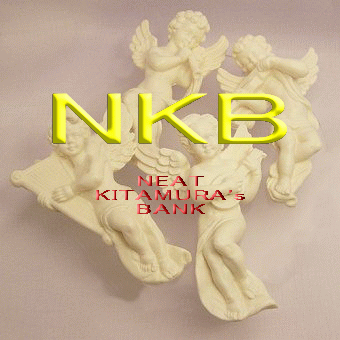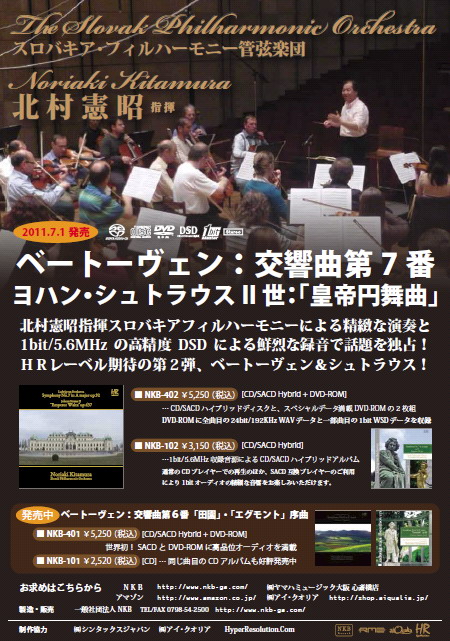

| @NKB@TOP@ | @contents | @CD@ | @shop@ | @Request@ | @Link@ |

The Second Album@
Beethoven Symphony
No. 7
Johann Strauss II gEmperor Waltzh
ConductFNoriaki kitamura
OrchestraFthe Slovak Philharmonic Orchestra
Recording placeFSlovak Bratislava Slovak Radio Hall
Recording dateFNovember 20`21 2010
@

@
used score F BÄRENREITER URTEXT TP907@iSymphony
No.7 in A Major op. 92j
@@@@ @@ BREITKOPF & HÄRTEL igEmperor
Waltz h op. 437j
recording sound source F It was recorded
to the most up-to-date model i1bit recorder of KORG Co.j
by Japanese engineer Mr. Teruo Murakami.
* homepage of recording engineer Mr. Teruo
Murakami F http://www.mu-s.com/
@
Conductorfs
comment
@Also this time I used the score of above URTEXT ithe original text editionj for Beethoven. As a matter of common sense in the present, I made an effort to meet the composerfs aim as possible as I could. I used the general score for gEmperor Waltzh.
@The point that differ with the score is tempo as the same
as the first album.
@I have some doubt about the tempo that is written by Beethoven
himself essentially. I have claimed there were problem of
graduation of metronome in those days and it is fast about 10 %.
Therefore the tempo that suits to my thought is standard. But the
most important aim of my performance is neat one of neat sound.
Itfs no problem to be influenced by the present situation, I
feel. On the whole, the tempo resulted a little slow.
@I made no alteration else insistently this time.
@I don't stick to this place for recording of Symphony No. 7 as much as the last recording of gPastoralh.
@When I perform the music of Beethoven I only notice gthe period style of renditionh. It is a historical style and becoming the common sense around Europe etc. these days. And the traditional style of this area is approximate to it.
@For example, in many cases people usually play stringed
instruments with no vibrato in this area. Once it was usual in
@I didn't give instructions especially, but they performed with no vibrato fundamentally. Of course wind instruments were played the same way.
@Especially they were through in the second movement. And I
hoped, too.
@There is a great difference between doing under conductorfs
instruction and doing willingly.
@According to that, the sound of non-harmony (discordance)
and itfs solution (entension resolve) are showed clearly and
the ensemble is very wonderful.
@It is proof of the high ability of ensemble of this orchestra.
@I was satisfied with the result so much.
@The reason why I chose Johann Strauss II gEmperor Waltzh
for coupling is that
@It may be said that these are in the same culture area.
Indeed, New Year Concert is held every year in this city and
waltz and polka of Strauss are performed.
@Moreover, though it is not announced officially so, many
players take part in the members of orchestras that come to Japan
every New Year. The names of orchestras have
@I dare to advocate for their honor, they were also
@When you hear this elegant performance you will understand
that they perform waltz as same as
@I feel more yearning rather than present
@
@Well, I was also accompanied with recording engineer Mr.
Teruo Murakami from
@Needless to say, the first recording was so wonderful. And I thought that he is the only one who can recognize my aim and can capture the neat sound created fully in the space.
@I requested only one point this time.
@The mike was set at the same position as the last recording, but there were somewhat incomplete sound in gPastoralh.
@I didnft feel that while I conducted.
@I thought it might be caused by setting of mike.
@Members of orchestra sit apart around wide space.
Difference in time has come out from corner to corner.
@Players of orchestra perform as they revise the time lag.
@Therefore difference comes out when performance is recorded by
nearby mike. The timing is so delicate.
@I had misgivings about it might proved fatal to No. 7 especially to III and IV movements.
@I asked to make up countermeasure for it. It was perfect.
@I think it was a big virtue of introducing deep sound of
strings of this orchestra also this time.
@I also think it was a big success of recording the elegant and
naive music of this orchestra by gEmperor Waltzh.
@I would like to take this opportunity to express my
appreciation to members of the Slovak Philharmonic Orchestra,
manager Ms. Tatiana Schoeferova, Mr. Pavel Hruby, and interpreter
Ms. Kinga Valent. She took care of us well during our stay. I
would like to thank engineer Mr. Hubert Geshwandtner and producer
Mr. Emil Niznansky of the Slovak Radio. I deeply thank recording
engineer Mr. Teruo Murakami who has been with me from
Conductor Noriaki Kitamura
|
| @ |
|
There are two media of recording this time.
Above #102 is SACD/CD
Hybrid Disc.
You can listen by usual CD player and enjoy more high quality
sound by SACD player.
3150 yen (includes tax)
Bellow #402 is a set
of two discs.
SACD/CD Disc
and DVD-ROM Disc of WAV data (24 bit/192 kHz) and WSD data (1
bit) of a part
5250 yen (includes tax)
@
Schumann Symphony No.
1 gSpringh and No. 4
Noriaki Kitamura conduct, Moravian Philharmonic Orchestra
was re-mastered by CD recording engineer Mr. Teruo Murakami.
1575 yen (includes tax)
@
@order
Please write your address, name, telephone number and number(s) of order for
#102 Beethoven No. 7 SACD/CD - disc(s)
#402 Beethoven No. 7 SACD/CDDVD-ROM - set(s)
@#301 Schumann - disc(s)
then please mail to
@
‘@you can get at the store bellow@‘
τYAMAHA MUSIC Co. Osaka Shinsaibashi Storeτ@
@§TSQ|OOWT@
Q|W|T Shinsaibashi-suji
Chuuou-ku OSAKA
@TELFOU|UQPP|TRUO@
@FAXFOU|UQPP|WOOS
MAILF@nkbankga@yahoo.co.jp
copyright 2010 NKB gen. as. All right reserved
@
@